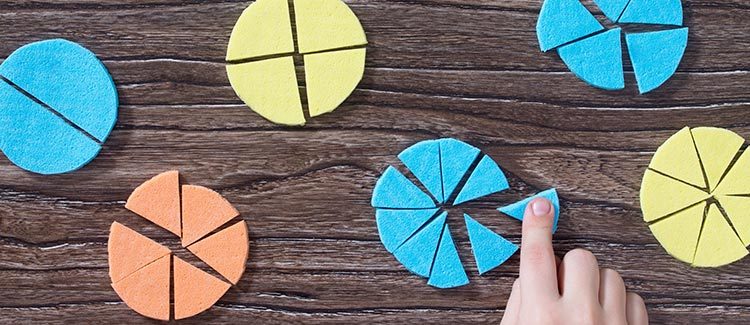Headaches over math homework? Here’s how you can help.
-
Fraction action
This year your child will need to master transforming mixed numbers like 2 ½ into fractions (5 halves). Help them understand this concept with playdoh by asking them to make 2 whole circles and another half circle. Next, split the circles into halves and count up all the halves they see. Touching and seeing the whole number turned into a fraction will help the concept stick. Here’s an easy 4th grade worksheet to review the idea.
-
Line ’em up! Working with decimal numbers
Another year, another decimal place. This year 5th graders work with decimals to the thousandths place (4 places past the point). The good news? They do the same thing as they did with hundredths! Compare, add, and subtract! Make sure they line them up properly to get correct answers and avoid confusion. Here’s a worksheet that helps with subtracting to thousandths place.
-
Mental math workout
Your 5th grader may be learning more sophisticated math, but they should keep the arithmetic skills fresh. Ask them to use mental math while grocery shopping with you by having them keep a mental list of prices for items in your basket. Then round and predict what the total cost will be. Notebooks are ok at first, but once they get the hang of it have them to try it in their heads. Get more strategies for making math relevant in everyday life.
-
Volume is not just a button on the remote
Your fifth grader is learning to figure out how many cubed units (tiny cubes) fit into a three-dimensional shape, like a box (also called a rectangular prism). Help your child understand this concept by filling a box up with little cubes. If you don’t have any, try paperclips, marbles, or erasers of the same size. Make sure they’re organized so all the space is taken up. Then ask, how many marbles fit into the box? Then, have your child give this worksheet a try.
-
What’s your estimate?
Before reaching for a calculator, pen, or pencil, your fifth graders should think about what the numbers in a word problem mean. When they see ⅗, they might recognize that it’s a little more than half, which can help them estimate the answer. But, make sure they follow up the estimate with concrete math. If their estimate is close to what they got, their estimation is on the right track. Give your child some estimation practice with this worksheet.
-
The scoop on fractions
This year, your fifth grader is learning that when you add fractions with different denominators, the first step is to find equivalent fractions with the same denominator. Help reinforce this idea by asking your child to find equivalent fractions in recipe measurements so they can tell you what ⅔ cup plus ½ cup equals. Give your child practice adding fractions with different denominators with this worksheet.
-
Factors made simple
Finding the factors of a number sounds complicated. Help make the concept less scary for your fifth grader by asking them to a set of objects into even groups. Take a number of beans, say 10. Can you put them in 1 group evenly? That’s a factor! How about 2? That’s also a factor. Keep going until you have all 10 beans in one group. Ten is a factor too! Next, try this out with numbers up to 30 using this worksheet.
-
Gathering and graphing data
The kids in your child’s class are a terrific source of data. Help your child think of four or five data points to collect, record as fractions, and document in circle graphs. For example: hair color. Have your child list every member of the class and write their hair color next to their name. Tally up the browns, blacks, reds, and blondes and express them as fractions (e.g. 11/32 brown, 12/32 black, 1/32 red, 8/32 blonde). Can your child express their data as fractions — and then in circle graphs? Use this worksheet for help and inspiration, too.
-
Graphing made concrete
Yes, your fifth grader is already graphing simple lines, but what’s the point? Help give the line meaning by telling your fifth grader you want to plan a party. It will cost you $3 per guest for food and drinks. Together, use the equation y = 3x to calculate how much money you’ll need (y) for a given number of guests (x). Try 7, 10, and 15 guests. How much money will you need for each number of guests? Then plot the points to see it visually. Get more strategies for making math relevant in everyday life.
-
Ideas for summer math practice
Reinforce your child’s arithmetic skills this summer with online sources of math games, explanations, and practice. Free websites like Khan Academy, Sheppard software, WebMath.com, Math.com, and IXL.com offer a variety of games, practice problems, and information for a wide range of grades and math levels. Encourage your child to explore these sites with you or on their own to see if they are helpful. This can be a fun way to keep your child from forgetting all they learned in math over summer break. For offline practice, check out our five favorite fifth grade worksheets covering skills like decimals, geometry, probability, and charts and graphs.






